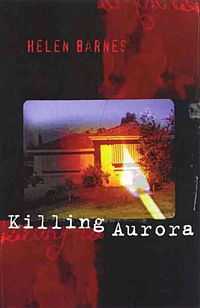Killing Aurora
|
First edition cover | |
| Author | Helen Barnes |
|---|---|
| Country | Australia |
| Language | English |
| Genre | Youth novel |
| Publisher | Penguin Books |
Publication date | 1 May 1999 |
| Media type | Print (Paperback) |
| Pages | 240 pp (first edition, paperback) |
| ISBN | ISBN 0-14-130532-0 (first edition, paperback) |
Killing Aurora is a novel by Helen Barnes about a girl with anorexia. It was published in 1999 by Penguin Books.
Plot summary
The novel contains two central characters, both fourteen years of age: the first, Aurora Thorpe (rabbit queen), has been forced by her overprotective mother and stepfather to attend the prestigious St Dymphna's Non-Denominational Ladies' College. The second, also attending St Dymphna's, is Web Richardson (rabbit king), an outcast from a single parent family. Aurora and Web share a prickly connection, despite Aurora's reluctance to be associated with the terribly unpopular Web.
In an abruptly unfamiliar environment, and under the pressure of family and social expectations, Aurora becomes increasingly concerned with losing weight as a means of achieving the acceptance of her peers and living up to her own rigorous standards. Meanwhile, Web endures life without a mother, having only the scant guidance of her timid father, overbearing aunt, bitter grandfather and volatile older sister to rely on. Web desperately tries to stop Aurora from "disappearing", at the same time struggling with her mother's absence and the need for a friend.
There are many references throughout the book to suggest that the school "St Dymphna's" is in fact the selective Mac.Robertson Girls' High School in Melbourne. This is the school that the author attended.
Thematic Concerns
The plot is structured around the physical and mental deterioration of Aurora as she suffers anorexia and her weight drops throughout the novel. However, the novel does not limit itself to exploration of the illness. Rather, Aurora's experience is used by Barnes as a lens to explore more broadly the effect of modern Australian middle class society on the female psyche and body image. This is shown through the novel's frequent references to advertising, television, magazines and the comments of men. It is also echoed through the stories of related characters. For instance, Web expresses revulsion at femininity, including her menstruation, bras, sexual relations (particularly her sister's but also Aurora's interest in boys), and mothering (both her aunt who she rejects, and her own mother, who she pretends is dead). Aurora's mother insists on maintaining her relationship with her new boyfriend Gary rather than be alone, even when it compromises her relationship with her daughter and son, and, like Aurora, has an unhealthy relationship with food. Aurora's schoolmate Pseu is prone to self-harm and as well as her fixation with suicide is concerned with the opinions of boys, including strangers on the train. Thus, the novel can be seen as a study of constructed female identity rather than a novel 'about anorexia'.
Release details
- 1999, UK, Puffin Books ISBN 0-14-130532-0, Pub date 1 May 1999, paperback
- 1999, UK, Penguin Books ISBN 0-14-028774-4, Pub date ? ? 1999, paperback
